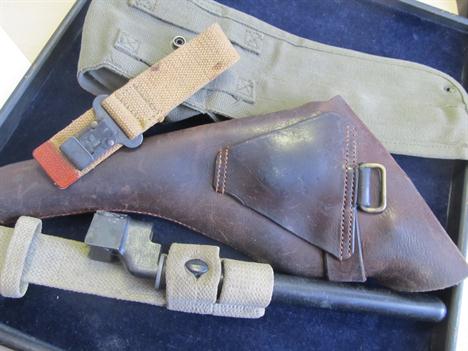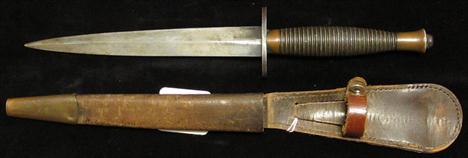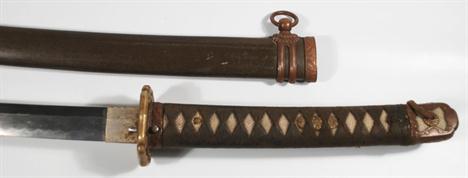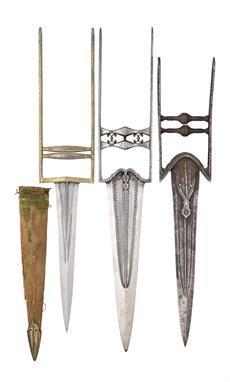We found 98577 price guide item(s) matching your search
There are 98577 lots that match your search criteria. Subscribe now to get instant access to the full price guide service.
Click here to subscribe- List
- Grid
-
98577 item(s)/page
Napoleonic Wars Naval Officers Dirk by Prosser (late Cullum) Sword Cutler to the King & HRH Duke of York. Broad curved blade 16" double edged towards the point. Gilt copper mounted hilt (gilding very worn) comprising recurred quillions with round finials. Back piece with lion head pommel and wire bound ivory grip (small loss to top of ivory grip). The leather parts of the scabbard are virtually all gone however the gilt copper locket with suspension ring, engraved "Prosser" and "Charing Cross London", and the central band with suspension ring have both survived with an inch or so of leather still attached. Early and interesting, ideal restoration project.
Sword - a 1796 type Pattern Light Cavalry Troopers Sword, broad curved blade 32" approx, with fuller and hatchet point. Ribbed wooden grip, stirrup guard with iron back piece with shield shaped ears. Lightly rusted overall, no scabbard, no visible markings. A good untouched example circa 1800 to 1815.
Sword - a 1796 type Pattern Light Cavalry Troopers Sword, broad curved blade 32" approx, with fuller and hatchet point. Twist wire bound fish skin grip, stirrup guard with iron back piece and circular ears. Cross guard with triangular shaped langets. Quillon broken near to cross guard, lightly rusted overall. No markings, No scabbard, overall sound condition
Sword - an 1821 Pattern Infantry Officers Sword by Wilkinson, Blade numbered `5826`. WSC records show this Sword was sold on 23.01.1855 at the height of the Crimean War. Embossed Blade 32 1/2". Wire bound Fishskin Hilt in good condition, in its leather field service Scabbard (repaired half way down) in worn condition. The Sword a good example of a Crimean War weapon. Sold with original Wilkinson Certificate/invoice (copy)
Sword - an 1895/97 Pattern Infantry Officers Sword Wirebound Fishskin Hilt (minor damage to Fishskin) In its Leather Field Service Scabbard. Blade etched with Crown V.R. Made by Wilkinson no. 14318. Dark Patina overall. Blade 32". Overall in good condition, an attractive Sword with its Steel Sword Scabbard. Nickel plated, slightly curved Sword Blade 32". Two Suspension Grips, minor rusting (2)
Unmarked Model 1941, U.S.Manufactured Dutch Kleewang. Pierced Hilt, Curved Cutlass blade 25" with clipped point. Bakelite grips secured by 3 Brass Rivets. In its Brass mounted leather scabbard stamped "CW" "N" and "4.41". Likely made by MILSCO (Milwaukee Saddlery Comp) in 1941. Overall a very good example, blued blade
A Victorian officers saber marked Dolan and Co St Martins Lane, London, on the forte, having 82cm approx blade etched and marked to the Volunteer Rifle Regiment among foliar decorations slightly curved blade, with single wide fuller for approx 2/3 length four bar steel guard with Shagreen grips, steel scabbard, good patina, circa 1850
**THREE SOUTHEAST ASIAN DAGGERS (KRIS), PHILIPPINES AND MALAYSIA, 19TH CENTURYof characteristic form, the first three Moro, the first with wavy blade engraved with a serpent along a short medial ridge, carved wooden grip with brass ferrule, in its scabbard; the second with wavy blade widening at the base, and carved wooden hilt with bird`s head pommel; the third Sumatran with wavy blade, and carved wooden hilt with beaked pommel of kingfisher form, and three various scabbardsthe first: 59 cm; 23 1/4 in blade(6)ProvenanceJWHA Inv. Nos. 2289, 3494, 3326, 178, 180, 210
**THREE MORO SHORTSWORDS (BARONG), AND TWO MALAY KAMPILAN, MORO OR DYAK, 19TH CENTURYthe first with leaf shaped blade, carved hardwood hilt with birds head pommel, the lower portion encased in sheet silver, in its two-piece scabbard bound with cane, inscribed in ink `From a Moro village……..bought by Carl Birch, April 4th1900`; the second similar (scabbard missing); the third with cleaver blade and carved hardwood grip; the fourth and fifth with tapering single-edged blades clipped back at the point, and carved hardwood grips (hilts with small chips throughout)the first: 41 cm; 15 1/4 in blade(5)ProvenanceThe first two: Milton R. Macintosh, Rhode Island, acquired December 1970, nos 61 and 65The fourth: Frank Gair Macomber, sold American Art Association, Anderson Galleries, New York, 10th-12th December 1936, lot 288The fifth: Burghard Steiner, Riverdale-on-Hudson, New York, sold Walpole Galleries, New York, 26th January 1927, lot 208JWHA Inv. Nos. 3553, 3554, 3473, 2410, 106
**TEN SOUTHEAST ASIAN EDGED WEAPONS COMPRISING A GOLOK, TWO DYAK PARANG LATOK, THREE PARANG, A TALIBON, A MORO PANABA,AND TWO FURTHER PIECES, MALAYSIA AND PHILIPPINES, 19TH CENTURYthe first with engraved blade and carved wooden grip including a stylised bird`s head, in its scabbard; the second and third with characteristic angular blades swelling towards the tips, and carved wooden grips one bound with rattan and the other with brass; the fourth with broad blade and shaped wooden grip; the fifth and sixth with sickle-shaped blades and long wooden grips; the seventh with long slender tapering blade; the eighth with curved blade formed with an angular tip, and long wooden grip, together with a sword cane and a Malay knife with pattern welded blade and pistol grip (small chips and losses throughout)the first: 37.5 cm; 14 3/4 in blade(10)ProvenanceThe second, third, sixth: Andover Newton Theological School, Massachusetts, 22nd March 1946The fifth: Milton R. Macintosh, Rhode Island, acquired December 1970, no. 54The seventh: Walpole Galleries, New York, 31st May 1927, lot 363The eighth: Francis Bannerman & Sons, New York, 9th May 1944JWHA Inv. Nos. 2113, 3476, 3483, 2172, 3557, 3324, 332, 2747.1, 1978.03.05, 3308
**A KUBA SHORTSWORD (IKUL), 19TH CENTURYwith broad tapering iron blade, blackened over a central profusely grooved triangular panel, hardwood grip inset with numerous brass nails on the top, in its wooden scabbard, profusely studded with brass nails35.8 cm; 14 in bladeProvenanceNewton Theological School, Massachusetts, 22nd March 1946JWHA Inv. No. 3490The Ikul was, by tradition, introduced as a symbol of peace by King Shyaama Mbula Ngoog in the early 17th Century.
**TEN AFRICAN EDGED WEAPONS, 19TH CENTURYthe first Fang tribe, with double-edged engraved steel blade, recessed ricasso, and carved hardwood grip, the second similar, the forte incorporating two points and the grip bound with brass wire; the third Zaire, with cleaver shaped blade, hardwood hilt including mushroom shaped pommel studded with brass nails; the fourth possibly Kru tribe, with cleaver shaped partially blackened double-edged blade formed with a hooked point, and carved hardwood grip with conical pommel; the fifth Nigerian, a Munshi archer`s dagger; with loop shaped hilt; the sixth a Bornu dagger, with brass hilt, in its leather scabbard; the seventh Central African probably made from a cut-down spear, with leaf-shaped steel head, brass bound socket and wooden grip, in its leather scabbard; and three further daggers and a scabbardthe first: 41.5 cm; 16 1/4 in blade(11)ProvenanceThe first, third, fourth: Newton Theological School, Massachusetts, 22nd March 1946The second, sixth, seventh: Milton R. Macintosh, Rhode Island, acquired December 1970, nos. 24, 98, 69The fifth: William Ockelford Oldman, London, 1st May 1931JWHA Inv. Nos. 3484, 3670, 3487, 3480, 1621, 3773, 3760, 194, 1602, 3479, 1612
**A SUDANESE SWORD (KASKARA), ARM DAGGER, A UGANDAN WRIST KNIFE, A MASSAI SWORD (OL ALEM) , AND TWO NORTH AFRICAN DAGGERS (JAMBIYA), 19TH CENTURYthe first with straight double-edged blade etched with an inscription on each face, brass hilt of characteristic form with traces of silver plating, and leather-covered wooden grip rising to a disc-shaped pommel; the second with straight tapering double-edged blade, carved wooden grip, disc shaped pommel, in its scabbard complete with leather loop; the third, formed of a steel disc enriched with brass, and the inside lined in leather; the fourth with slender double-edged blade, rudimentary wooden hilt bound with brass wire, in its matching scabbard; the fifth with curved blade stamped with a dagger mark on one side, carved horn grip, in its engraved white metal scabbard; the fifth Moroccan, of characteristic form, with hardwood grip applied with engraved silver and brass, in its brass scabbard enriched with silver, and a further scabbard for a Moroccan flyssathe first: 89.2 cm; 35 1/4 in blade(7)Provenance The second, fifth and sixth: Milton R. Macintosh, Rhode Island, acquired December 1970, nos. 74, 93, 72The third and fourth: William Ockelford Oldman, London, 1st May 1931JWHA Inv. No. 2058, 3776, 1597, 1620, 3780, 3762, 181
**AN OTTOMAN SILVER-MOUNTED SWORD (YATAGHAN), BALKANS, 19TH CENTURYwith slender slightly curved blade stamped with a mark on one side, silver hilt cast and chased with traditional scrolls and trophies-of-arms in low relief, eared pommel, in its wooden scabbard encased in two sections of silver, the lower decorated with architectural and maritime scenes, and bouquets all within scrollwork frames, and the upper section banded45.5 cm; 18 in bladeProvenanceBurghard Steiner, Riverdale-on-Hudson, New York, sold Walpole Galleries, New York, 26th January 1927, lot 90JWHA Inv. No. 70
**AN OTTOMAN DAGGER, BALKANS, LATE 19TH/20TH CENTURYwith curved double-edged blade formed with a medial ridge, decorated with gold koftgari on each face at the forte, wooden hilt of characteristic form, encased in thin sheet silver, decorated with flowers and foliage, in its wooden scabbard encased in silver decorated en suite with the hilt 34 cm; 13 1/2 in bladeProvenanceGiulia Morosini, sold American Art Association, New York, 10th-15th October 1932, lot 61JWHA Inv. No. 3294
**TWO OTTOMAN DAGGERS (JAMBIYA) AND TWO SCABBARDS, BALKANS AND PERSIA, LATE 19TH/20TH CENTURYthe first small, with double-edged blade decorated with silver koftgari flowers, hilt of characteristic form profusely overlaid with silver beadwork and twisted wire, in its scabbard decorated en suite; the second with curved double-edged blade formed with a medial rib, and steel hilt etched with foliage inhabited by birds; the third for a shamshir, formed of a wooden core covered with green leather (broken); and the last for a short shamshir or kilig, covered with brown leatherthe first: 11.5 cm; 4 1/2 in blade(4)ProvenanceThe first and second: Milton R. Macintosh, Rhode Island, acquired December 1970, nos. 97, 75JWHA Inv. No. 3767, 3659, 191, 195
**A NEPALESE SHORTSWORD (KORA), FOUR NEPALESE SHORTSWORDS (KUKRI), 19TH AND 20TH CENTURIESthe first of characteristic form, with broad blade swelling to a double-cusped tip, chiselled on each side with foliage on the back-edge, at the tip with a rondel filled with a mounted figure and a sun-in-splendour respectively, and with a chiselled brass figure in low relief on one face at the forte, and iron hilt of talwar form; the kukris of characteristic form, the second with chased white metal grip; the third chiselled with figures in traditional dress on the broad blade, and khanjar hilt decorated en suite; the fourth with hardwood grip, in its scabbard; the fifth of characteristic form, with carved hardwood grip, and a scabbard for a Ghurka kukri knife, with pierced and chased silver locketthe first: 57 cm; 22 1/2 in blade(6)ProvenanceThe second: R. McAlpine Woods, Miami, Florida, 31st March 1953The third: Walpole Galleries, New York, 22nd January 1927, lot 521The fourth: Dr. Bashford Dean, Riverdale, New York, 28th September 1929, no. 13JWHA Inv. No. 2050, 3198, 105, 957, 3481; 823.b
**AN INDIAN DAGGER (JAMBIYA), AN INDIAN DAGGER (BICHWA), AND A COMBINED CRUTCH AND CONCEALED DAGGER (FAKIR`S CRUTCH), 19TH/20TH CENTURYthe first with curved double-edged blade decorated with silver scrolls at the forte, steel hilt decorated en suite, in its matching scabbard; the second with a pair of recurved double-edged blade, and engraved brass loop-shaped hilt chiselled with a panel of foliage top and bottom, and retaining an early padded lining; the third with very slender blade, and characteristic steel body and scabbard with traces of silver decorationthe first: 22.5 cm; 9 in blade(3)ProvenanceThe first: Milton R. Macintosh, Rhode Island, acquired December 1970, no. 76The second: L. H. Auron, Dorchester, Massachusetts, 12th February 1958JWHA Inv. Nos. 3768, 3149, 2124.1
**TWO INDIAN DAGGERS AND AN INDIAN NAGA SWORD (DAO), 19TH/ EARLY 20TH CENTURYthe first with katar blade decorated with a pair of feeding elephants in silver koftgarin one side and a zebra and elephant on the other, iron hilt of jambiya form, decorated with flowers on one side in silver (worn); the second with etched tapering double-edged blade, chiselled iron hilt decorated with exotic beasts and foliage enriched with gold koftgari; the third with blade of flattened diamond section widening towards the pierced tip and inlaid with two brass and two copper rondels, carved hardwood hilt; and a scabbard for a Ceylonese piha kaeta, with fluted wooden body and silver mountsthe first: 28 cm; 11 in blade(4)ProvenanceJWHA Inv. Nos. 3291, 2123, 2055, 183
**AN INDIAN SWORD (TALWAR)with single-edged blade of watered steel decorated with gold koftgari flowers and foliage at the forte (the upper third of the blade missing), steel hilt decorated over its surface with elaborate patterns of flowers and foliage within linear frames, in its fabric-covered wooden scabbard encased in steel, pierced with a running pattern of foliage enriched with gilding and some blued finish51.5 cm; 20 1/4 in bladeProvenanceEdmund C. Converse, sold American Art Association, 26th November 1927, lot 265JWHA Inv. No. 399
**THREE INDIAN DAGGERS (KATAR), 19TH CENTURYthe first with narrow tapering blade formed with a reinforced point, cut with two pairs of converging fullers and retaining traces of watered pattern on each face, iron hilt of characteristic form, retaining some gold decoration including a band of scrolling flowers, in its wooden scabbard with gilt copper chape and some green fabric covering (scabbard worn); the second with sharply tapering blade formed with a reinforced point, cut with a pair of converging fullers chiselled with leafy borders and a central slender panel of leafy foliage on each face, characteristic steel hilt including a pair of faceted grip bars joined by small globular moulded arms; the third with tapering fullered blade formed with a reinforced tip. iron hilt extending over the forte in a shaped foliate panel, formed with a pair of pierced tapering side bars, and a pair of moulded grip bars (patinated)the first: 23 cm; 9 1/8 in blade(3)ProvenanceThe first: Clapp & Graham Co. Inc., 514 Madison Avenue, New York, 12th January 1927The second and third: William Ockelford Oldman, London, 8th January 1947JWHA Inv. Nos. 21, 1555, 1554
**AN INDIAN FOLDING DAGGER (KATAR) AND AN INDIAN DOUBLE DAGGER (KATAR), LATE 19TH CENTURYthe first with concealed tapering double-edged blade, a pair of outer blades enclosing the former, decorated with a central panel filled with exotic bests in gold koftgari, steel hilt decorated en suite, including a pair of moulded grip bars, the lower opening the scabbard; the second with tapering blade decorated with a central panel filled with silver foliage, characteristic hilt decorated with silver en suite, in its matching scabbard formed as a larger katarthe first: 20.5 cm; 8 in blade(2)ProvenanceThe second: Frank Gair Macomber, sold American Art Association, Anderson Galleries, New York, 10th-12th December 1936, lot 265JWHA Inv. Nos. 64, 2406
**A GERMAN SCABBARD LOCKET, DATED 1679, PERHAPS SAXONYof tapering gutter section, the outer face boldly chiselled with scrolling foliage and a miner in contemporary dress, the inner face with two crossed loops for suspension, chiselled with the date and a crossed axe device10.5 cm; 4 1/8 in highProvenanceSumner Healey, sold Coleman Auction Galleries Inc., New York, 14th February 1940, lot 760JWHA Inv. No. 2573The crossed axe device is similar to that found on Saxon miners axes of the period.
**A HUNGARIAN MAGNATE`S SABRE, MID-19TH CENTURYwith curved fullered polished steel blade double-edged toward the point, gilt-brass hilt cast in low relief, comprising a pair of writhen quillons issuant from gaping masks and with flaming terminals, langets with the crowned Hungarian arms within a wreath, grip with a sun-in-splendour in the centre, and the pommel formed as a deity, in its fabric-covered wooden scabbard (worn), with gilt-brass mounts comprising locket, chape and two bands for suspension rings all decorated with scrolls, flowers and foliage, retaining traces of original enamelled decoration, and with an additional applied spray of foliage decorated en suite (chipped)82 cm; 32 1/4 in bladeProvenanceJWHA Inv. No. 3080
**A FINE MODEL ARMOUR BY E. GRANGER, PARIS, CIRCA 1850, IN THE GERMAN STYLE OF THE SECOND HALF OF THE 16TH CENTURYcomprising burgonet with high-combed skull, fixed peak, fixed peak and neck-guard and hinged cheek-pieces, collar of two lames front and rear, one-piece breastplate of `peascod` fashion fitted at its lower edge with a fauld of two lames carrying at its centre a hinged codpiece and, at each side, a long tasset of six lames articulated by a winged poleyn of three lames to a full-length tubular greave with integral broad-toed sabaton of nine lames, one-piece backplate with fixed culet of one lame, large symmetrical pauldrons each of six lames fitted at its apex with an upstanding haute-piece and connected at its lower end, via a turner, to a tubular vambrace with a winged bracelet couter of three lames, and fingered gauntlets (the fourth finger-defence of the left detached and the end of the thumb-defence missing), each with flared and pointed cuff, decorated throughout with copper rivets and rosette-washers, and mounted on an articulated mannequin with bronze head, clothed in buff leather (small split at inside of right thigh) and a dagged skirt of mail, and accompanied by a sword with straight quillons and an oval side-ring, contained in a red leather scabbard with chape and locket of iron32.5 cm; 12¾ in (with mounting-screws projecting from feet)ProvenanceJWHA Inv. No. 3845The maker of this armour, E. Granger of 70 Rue de Bondy (now Rue René Boulanger) Paris, exhibited models of this type as early as 1844 in the Exposition des Produits de L`Industrie Française, Paris. He later showed his work, as part of the firm of Granger-Leblanc, at the London International Exhibition on Art and Industry and Art held in the gardens of the Royal Horticultural Society, South Kensington, in 1862. Granger also made full-sized armours for some of Madam Tussaud`s waxwork figures and for stage use by the Paris Opéra, and was further listed as a maker of gilt jewellery, bronzes and occult objects.
**A FINE SILVER-MOUNTED CENTRAL AMERICAN KNIFE OF PRESENTATION QUALITY, CIRCA 1865-86with tapering blade double-edged for its upper half, inscribed `Por Rufino Flamenco En Sn Salvador` on the back-edge, chiselled with elaborate scrolls of foliage within a recessed panel on each face and set with two gilt plaques, one inscribed `JMM` (small areas of light staining, chiselled metal ferrule decorated with animals including hounds, a squirrel and a horse, two-stage faceted silver grip, finely chased with alternating panels of scrolling foliage and conventional flowers, in its silver scabbard, finely chased with bold scrolls of foliage and differing flowers inhabited by birds and a hound, one side with a rondel filled with the arms of Columbia enclosed by the inscription `Bogota Estados Unidos de Columbia`, and on the other with two rondels, one with the American eagle charged with a shield and the inscription `United States of America` and the other with the arms of El Salvador and the abbreviated inscriptions for Nicaragua, Costa Rica, Guatemala and Honduras, the outer face with belt hook chased en suite, and remaining in fine condition throughout37.8cm; 14 7/8in overallThe initials on the blade are almost certainly those of José Maria Medina, president of Honduras for eleven terms during the period 1863-76. El Salvador only supported Medina during his first period as president. In 1865 Honduras and El Salvador signed the Tratado de Defensa Centroamericana which included a defence agreement between Nicaragua, Costa Rica, Guatemala and Honduras. It is likely that the knife was intended for presentation at this time, though for reasons now obscured, this never happened which would explain the absence of further initials on the reverse gold escutcheon. Medina was clearly held in high regard by his contemporaries, a letter dated 1st June 1864 to him from William H. Seward on behalf of President Abraham Lincoln records the good relations that Medina strived to maintain between the United States and Honduras, and their desire to maintain this for the foreseeable future. However, Medina`s fortune was not to last, he was ousted from power in 1872 and executed by firing squad four years later.
**A BRITISH COMPOSITE OFFICER`S SWORD; AN 1853 PATTERN CAVALRY TROOPER`S SWORD AND AN 1885 PATTERN CAVALRY TROOPER`S SWORDthe first with etched regulation Naval blade based on the 1845 pattern, steel triple-bar hilt, and wire-bound fishskin-covered grip; the second of regulation type, in its scabbard; and the third of regulation type, stamped with War department and inspector`s marks at the forte, in its scabbardthe first: 69 cm; 27 1/8 in blade(3)ProvenanceThe second and third: Milton R. Macintosh, Rhode Island, acquired December 1970, nos. 6, 10JWHA Inv. Nos. 2068, 3611, 3582
**AN OFFICER`S SWORD, PROBABLY BRITISH EARLY 19TH CENTURY; A BRITISH LIFE-GUARD OFFICER`S SWORD, SECOND QUARTER OF THE 19TH CENTURY; A BRITISH 1897 GEORGE V INFANTRY OFFICER`S SWIRD; AND AN OFFICER`S SPADROON, EARLY 19TH CENTURYthe first with curved fullered single-edged blade etched and gilt with foliage and trophies on a blued panel at the base (worn), brass stirrup hilt (restored), and horn grip; the second with associated blade of regulation type, gilt-brass hilt including boatshell guard engraved with an expanded flowerhead in the centre and a border of foliage on the inside, the outer face reinforced with a steel and, engraved pommel, and wire-bound grip, with scabbard (incomplete, now in two pieces); the third with etched blade, plated hilt, in its leather field service scabbard; and the fourth with earlier fullered blade struck with a mark (probably the running fox of Shotley Bridge), brass hilt and fluted hardwood gripthe first:75.5 cm; 25 3/4 in blade(4)ProvenanceThe third: Milton R. Macintosh, Rhode Island, acquired December 1970, no. 18JWHA Inv. Nos. 3501, 3278, 3598
**A POST 1902 NAVAL OFFICER`S SWORD BY S.W.SILVER & CO., CORNHILL, LONDONof regulation type, with etched blade (areas of pitting), gilt-brass hilt, bullion sword knot, in its brass-mounted leather regulation scabbard79.5 cm; 31 3/8 in bladeProvenanceMilton R. Macintosh, Rhode Island, acquired December 1970, no. 7JWHA Inv. No. 3571
**A FRENCH MODEL A.N. XI HEAVY CAVALRY SWORD, DATED 1814of regulation type, with tapering blade cut with a pair of full-length fullers, engraved with Klingenthal Royal arsenal inscription and the date on the back edge, stamped with three marks at the forte including that of Etienne-Louis Borson (Director from 1st August 1814), a further mark, B within a wreath, and the mark of Francois Louis Lobstein, regulation brass hilt numbered `274` in its steel scabbard numbered en suite96.5 cm; 38 in bladeProvenanceIrene Garson Strauss, Brookline, Massachusetts, 13th September 1951JWHA Inv. No. 2913
**TWO FRENCH MODEL 1822 LINE CAVALRY TROOPERS SABRESthe first of regulation type, inscribed `Coulaux Aîné` and with Klingenthal Royal arsenal inscription on the back-edge, stamped with inspector`s marks at the forte, in its steel scabbard; and the second similar (scabbard missing)97.5 cm; 38 3/8 in blades(2)ProvenanceGiulia Morosini, sold American Art Association, New York, 10th-15th October 1932, part of lots 120, 125JWHA Inv. No. 1852, 1858
-
98577 item(s)/page



























































